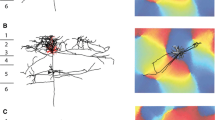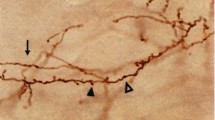Summary
The purpose of this work was to determine the number and morphology of pyramidal tract (PT) axons in the cat, using electron microscopy, modern methods of fixation, and computer-assisted morphometric analysis. Sections taken at the level of the medullary pyramids in three animals were fixed and magnified up to 10,000 x to produce photomicrographs. Morphological data were entered into computer files for analysis by tracing axon perimeters on micrographs mounted on a digitizer tablet. The number of axons per PT averaged 415,000, of which 88% were myelinated and 12% were unmyelinated. 90% of the myelinated axons fell in the diameter range 0.5–4.5 μm. Axons larger than 9 μm diameter accounted for 1% of the total; the largest were 20–23 μm. Myelinated axon mean diameter was 1.98 μm; because of the skewed distribution, with many small axons and a few very large axons, median diameter was 1.60 μm. Size distribution was relatively uniform throughout the PT cross section, with all sizes represented in all regions. However, the more medial regions had a higher proportion of small fibers than the more lateral regions: mean medial diameter was 1.85 μm while mean lateral diameter was 2.09 μm. Myelin sheath thickness averaged 7.9% of fiber diameter for axons up to 11 μm, but was constant at 0.9 μm for larger fibers. Myelinated fibers were distorted from the circular shape in cross section, with a mean circularity index (or form factor) of 0.85, which implies that the fibers could swell about 15% without rupture of the cell membrane. Unmyelinated fibers averaged 0.18 μm diameter (range 0.05–0.6 μm); the largest unmyelinated axons were larger than the smallest myelinated axons. It is concluded that previous work greatly underestimated the number of axons in the cat pyramidal tract.
Similar content being viewed by others
References
Arbuthnott ER, Boyd IA, Kalu KU (1980) Quantitative study of the non-circularity of myelinated peripheral nerve fibers in the cat. J Physiol (Lond) 308: 99–123
Beyer WH (1966) Handbook of Tables for Probability and Statistics. Chemical Rubber Co, Cleveland, Ohio USA
Biedenbach MA, Beuerman RW, Brown AC (1975) Graphic digitizer analysis of axon spectra in ethmoidal and lingual branches of the trigeminal nerve. Cell Tiss Res 157: 341–352
Biedenbach MA, Towe AL (1970) Fiber spectrum and functional properties of pyramidal tract neurons in the American Opossum. J Comp Neurol 140: 421–430
Brookhart JM, Morris RE (1948) Antidromic potential recordings from the bulbar pyramid of the cat. J Neurophysiol 11: 387–390
Crevel H van, Verhaart WJC (1963) The rate of secondary degeneration in the central nervous system. I. The pyramidal tract of the cat. J Anat 97: 429–449
DeMyer W (1959) Number of axons and myelin sheaths in adult human medullary pyramids: study with silver impregnation and iron hematoxylin staining methods. Neurology 9: 42–47
DeMyer W, Russell J (1958) The number of axons in the right and left medullary pyramids of Macaca rhesus and the ratio of axons to myelin sheaths. Acta Morph Neerl Scan 2: 134–139
Deschenes M, Labelle A, Landry P (1979) Morphological characteristics of slow and fast PT-cells in the cat. Brain Res 178: 251–274
Dunkerly GB, Duncan D (1969) A light and electronmicroscopic study of the normal and the degenerating corticospinal tract in the rat. J. Comp Neurol 137: 155–184
Forrester J, Peters A (1967) Nerve fibers in the optic nerve of rat. Nature 214: 245–247
Friede RL, Bischhausen (1980) The precise geometry of large internodes. J Neurol Sci 48: 367–381
Harding GW, Towe AL (1985) Fiber analysis of the pyramidal tract of the laboratory rat. Exp Neurol 87: 503–518
Hildebrand C, Hahn R (1978) Relation between myelin sheath thickness and axon size in spinal cord white matter of some vertebrate species. J Neurol Sci 38: 421–434
Hughes A, Wassle H (1976) The cat optic nerve: fibre total count and diameter spectrum. J Comp Neurol 169: 171–184
Humphrey DR (1983) Corticospinal systems and their control by premotor cortex, basal ganglia, and cerebellum. In: Willis W (ed) The Clinical Neurosciences, Chap 12, Sect V. Neurobiology, Churchill-Livingston, New York
Humphrey DR, Corrie WS (1978) Properties of pyramidal tract neuron system within a functionally defined subregion of primate motor cortex. Exp Brain Res 41: 89–108
Huttenlocher PR (1970) Myelination and the development of functions in the immature pyramidal tract. Exp Neurol 29: 405–415
Landry F, Wilson CJ, Kitai ST (1984) Morphological and electrophysiological characteristics of pyramidal tract neurons in the rat. Exp Brain Res 57: 177–190
Langford LA, Coggeshall RE (1980) The use of potassium ferricyanide in neural fixation. Anat Rec 197: 297–303
Lassek AM, Rasmussen GL (1939) The human pyramidal tract: a fiber and numerical analysis. Arch Neurol 42: 872–876
Lassek AM, Rasmussen GL (1940) A comparative fiber and numerical analysis of the pyramidal tract. J Comp Neurol 72: 417–428
Leenen L, Meek J, Nieuwenhus R (1982) Unmyelinated fibers in the pyramidal tract of the rat: a new view. Brain Res 246: 297–301
Mediratta NK, Nicoll JAR (1983) Conduction velocities of the corticospinal axons in the rat studied by recording cortical antidromic responses. J Physiol (Lond) 336: 545–561
Patton HD, Amassian VE (1960) The pyramidal tract: its excitation and functions. Handbook of Physiology, Sect I. Neurophysiology 2: 837–861
Peters A, Palay SL, Webster H de F (1976) The fine structure of the nervous system: the neurons and supporting cells. WB Saunders Co, Philadelphia, Pennsylvania USA, pp 212–216
Reh T, Kalil K (1982) Development of the pyramidal tract in the hamster. II. An electron microscopic study. J Comp Neurol 205:77–88
Samorajski T, Friede RL (1968) A quantitative electronmicroscopic study of myelination in the pyramidal tract of rat. J Comp Neurol 134: 323–338
Takahashi K, Kubota K, Uno M (1967) Recurrent facilitation in cat pyramidal tract cells. J Neurophysiol 30: 22–34
Thomas A, Westrum LE, DeVito JL, Biedenbach MA (1984) Unmyelinated axons in the pyramidal tract of the cat. Brain Res 301: 162–165
Towe AL (1973) Relative numbers of pyramidal tract neurons in mammals of different sizes. Brain Behav Evol 7: 1–17
Towe AL, Harding GW (1970) Extracellular microelectrode sampling bias. Exp Neurol 29: 1366–1381
Vaney DI, Hughes A (1976) The rabbit optic nerve: fiber diameter spectrum, fiber count and comparison with a retinal ganglion cell count. J Comp Neurol 170: 241–252
Wiesendanger M (1981) The pyramidal tract: its structure and function. Handbook of behavioral neurobiology, Vol 5. Motor coordination. Plenum Press, New York
Author information
Authors and Affiliations
Rights and permissions
About this article
Cite this article
Biedenbach, M.A., DeVito, J.L. & Brown, A.C. Pyramidal tract of the cat: axon size and morphology. Exp Brain Res 61, 303–310 (1986). https://doi.org/10.1007/BF00239520
Received:
Accepted:
Issue Date:
DOI: https://doi.org/10.1007/BF00239520




